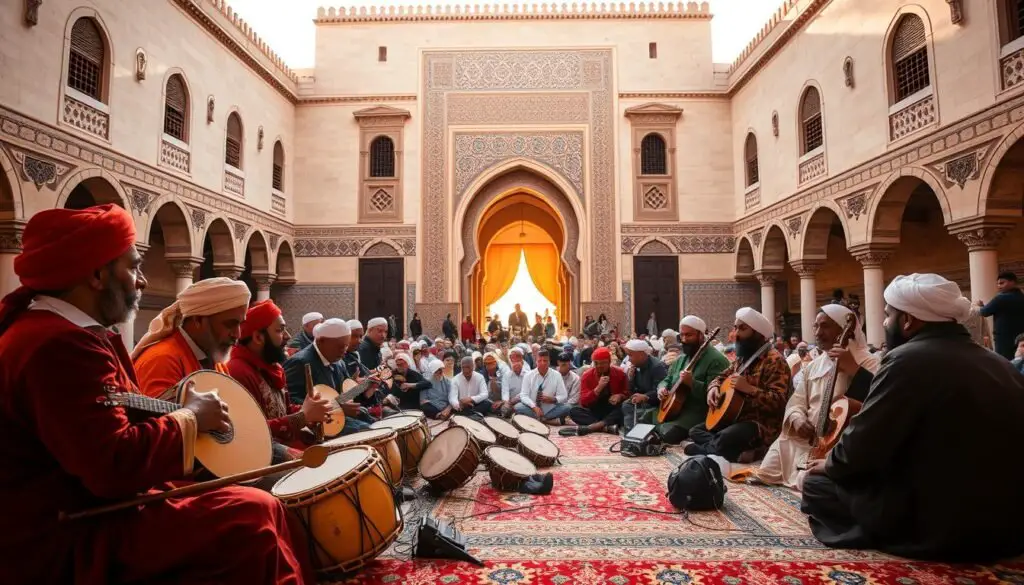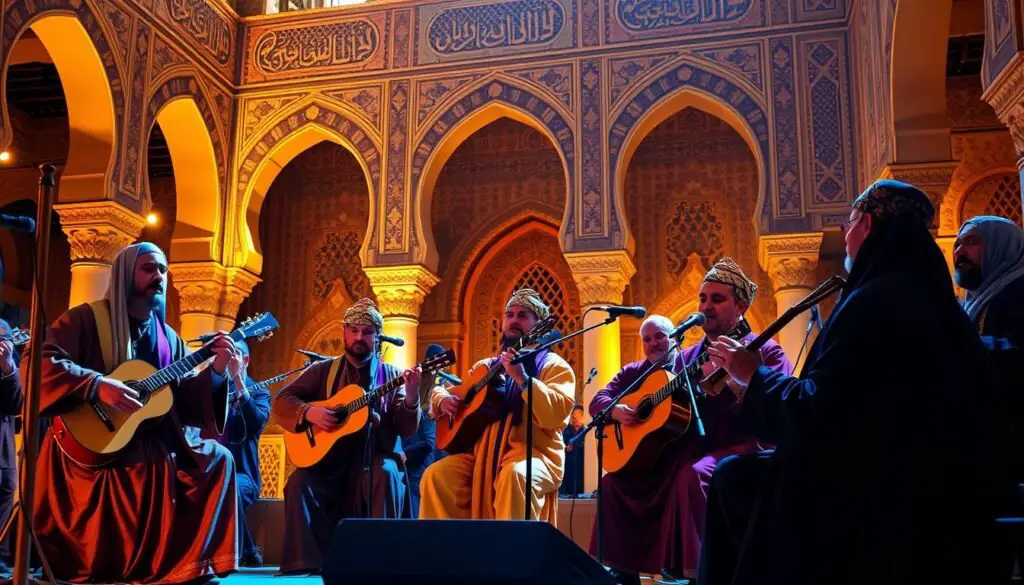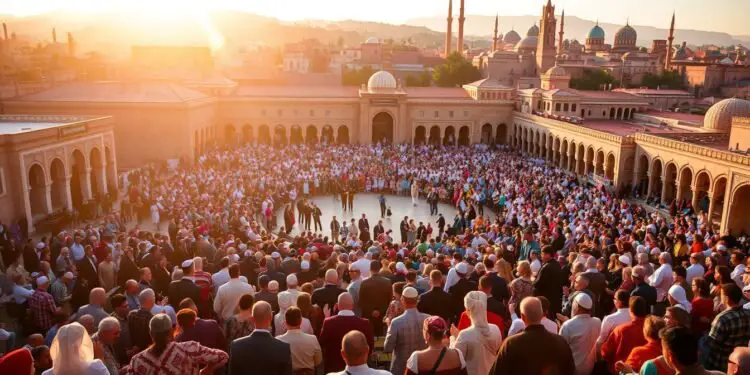Have you ever wondered how music can bridge cultures and faiths? The Fes Festival of World Sacred Music proves that melodies can unite people across continents. Founded in 1994 as a UNESCO initiative, this gathering celebrates spiritual harmony through diverse traditions.
Every year, Morocco transforms into a stage for Sufi chants, Hindu hymns, and Christian choirs. The event spans 10 days across historic cities like Fès and Marrakech. Artists from Spain, India, and beyond share their devotion through sound.
Beyond concerts, the festival fosters dialogue through workshops and debates. Its mission? To remind the world that shared rhythms can heal divides. Whether in Fès’ ancient medina or Chefchaouen’s blue alleys, the experience lingers long after the last note fades.
Key Takeaways
- Founded in 1994 to promote intercultural unity through spiritual melodies.
- Hosts artists from multiple faiths, including Sufi, Hindu, and Christian traditions.
- Features 10 days of performances in Morocco’s most iconic cities.
- Recognized by UNESCO for fostering global dialogue.
- Combines concerts with workshops and cultural immersion.
Discover the Fes Festival of World Sacred Music
The air hums with devotion as voices from Iran to Zanzibar rise together. This event transforms Morocco into a crossroads of spiritual expression, where rhythms dissolve borders.

A Celebration of Global Harmony
Artists from the Middle East, Africa, and beyond share stages under the stars. Iranian maestro Shahram Nazeri’s classical hymns echo alongside Turkish vocalist Gülay Haçer Toruk’s modern Sufi fusion. Each night, the Royal Ballet of Cambodia’s precise movements grace Bab Makina’s open-air square.
Dar Tazi Gardens host hypnotic rituals by Zanzibar’s Mtendeni Maulid group. Their chants blend with the call to prayer, creating a layered soundscape. Meanwhile, Bengali Baul dancers whirl through the medina’s alleyways, their ecstatic energy contagious.
History and Spiritual Significance
Founded in 1994 amid global tensions, this gathering aimed to unite through sacred music. The 17th-century Bab Makina became its iconic venue—a fortress turned stage for Cambodian dancers and French avant-garde experiments.
Night in the Medina takes audiences to synagogues and riads. Anatolian hymns meet jazz improvisations, proving devotion has no single language. Over 25 years, legends like Ravi Shankar have amplified its mission: harmony through shared melodies.
Cultural Impact and Unique Experiences
Beyond the melodies, this event offers hands-on cultural immersion. The city becomes a classroom where visitors learn through art, flavors, and moonlit rituals.

Venues: From Bab Makina to the Medina
The iconic Bab Makina hosts grand performances under starlit skies. Its Moorish arches frame dances from Tibet and Sufi chants. Meanwhile, the medina’s narrow alleys hide intimate concerts in riads.
Traditional Moroccan Arts and Cuisine
Roll up your sleeves for Zellij tile workshops or Arabic calligraphy classes. Food tours reveal secrets behind tagine and pastilla. Local chefs teach recipes passed down for generations.
Workshops and Sufi Performances
As night falls, Dar Tazi gardens pulse with whirling dervishes. Rhythmic drumming guides their dance, a hypnotic end to the day. Daytime Q&A sessions deepen understanding of these traditions.
Performances That Transcend Borders
Melodies from Mali to Mongolia create a universal language at this spiritual gathering. Each year, stages ignite with rare instruments and cross-continental harmonies. The event thrives on collaborations that defy genre and geography.
Renowned Artists and Global Collaborations
The Blind Boys of Alabama have shared gospel roots with Malian duo Amadou & Mariam. Jazz saxophonist Archie Shepp fused improvisation with Caribbean Gwo Ka Masters’ pulsating rhythms.
Malian guitar legend Djelimady Tounkara bridged West African blues with American roots. Cuban pianist Roberto Fonseca and Malian vocalist Fatoumata Diawara crafted a dialogue between Havana and Bamako.
Highlights from Past Festivals
Parvathy Baul’s ecstatic Bengali folk chants left audiences spellbound. The Gotipuas’ Odissi dance blended acrobatics with devotional storytelling.
French singer Camille reimagined Bach in the medina’s moonlit courtyards. Tuvan throat singers Chirgilchin echoed Buddhist shamanic traditions through multiphonic harmonies.
Ahmed Essyad’s *Prohibited Voice* merged Sufi poetry with avant-garde composition. These performances prove that borders dissolve when artists speak the language of the soul.
Conclusion: Plan Your Journey to Fes
Ready to experience a place where melodies unite cultures? Secure your spot for May 13-22, 2025, when artists from across the globe gather in Morocco. Early bookings ensure access to limited-capacity venues and preferred hotels.
Discover Corps offers all-inclusive packages from $5,195, covering 4-5 star stays, meals, and guided tours. Choose between Casablanca’s Art Deco elegance at Hotel le Doge or Chefchaouen’s mountain retreats like Lina Ryad.
Pack wisely for sacred sites—modest attire is key. Explore pedestrian-only medinas by day, then unwind with sunset performances. Extend your trip to Marrakech’s palaces or Essaouira’s breezy coast for a perfect finale.
This event blends sound, soul, and stunning landscapes. Don’t miss your chance to be part of a world where music speaks louder than words.
FAQ
When does the event take place?
The festival typically occurs in June, offering a week-long celebration of spiritual sounds and cultural exchange.
Where is the main venue located?
Performances are held across iconic sites like Bab Makina and the historic Medina, blending ancient architecture with modern artistry.
Can I experience local traditions?
Yes! Alongside concerts, enjoy Moroccan crafts, Sufi dances, and cooking workshops showcasing regional flavors.
Who are the featured performers?
Past editions included legends like Ravi Shankar and Björk, alongside rising stars bridging continents through melodies.
Are tickets required for all events?
Some daytime activities are free, while evening shows require passes. Early booking is recommended due to high demand.
How do I explore Fes beyond the festival?
Guided tours reveal the city’s 9th-century heritage, from tanneries to Al Quaraouiyine University.
What’s the best way to reach the city?
Fes-Saïss Airport connects internationally, or take a scenic train ride from Casablanca or Marrakech.




